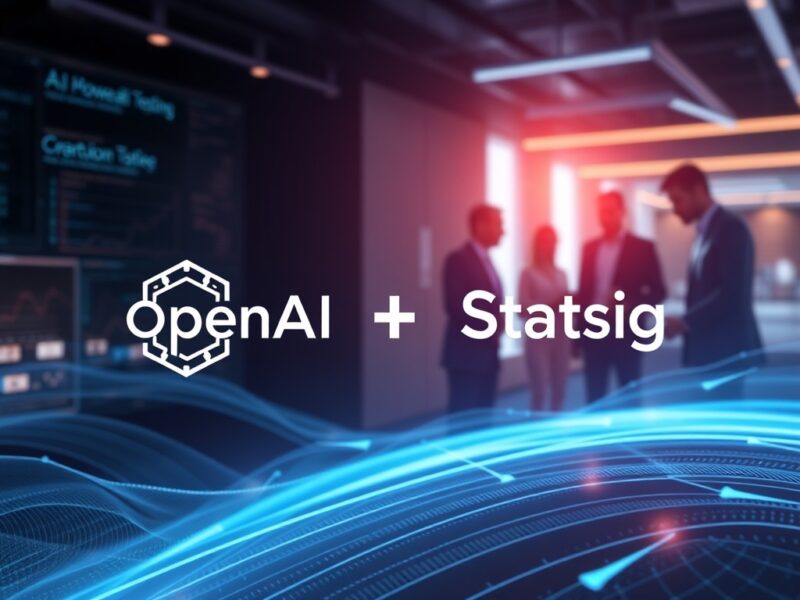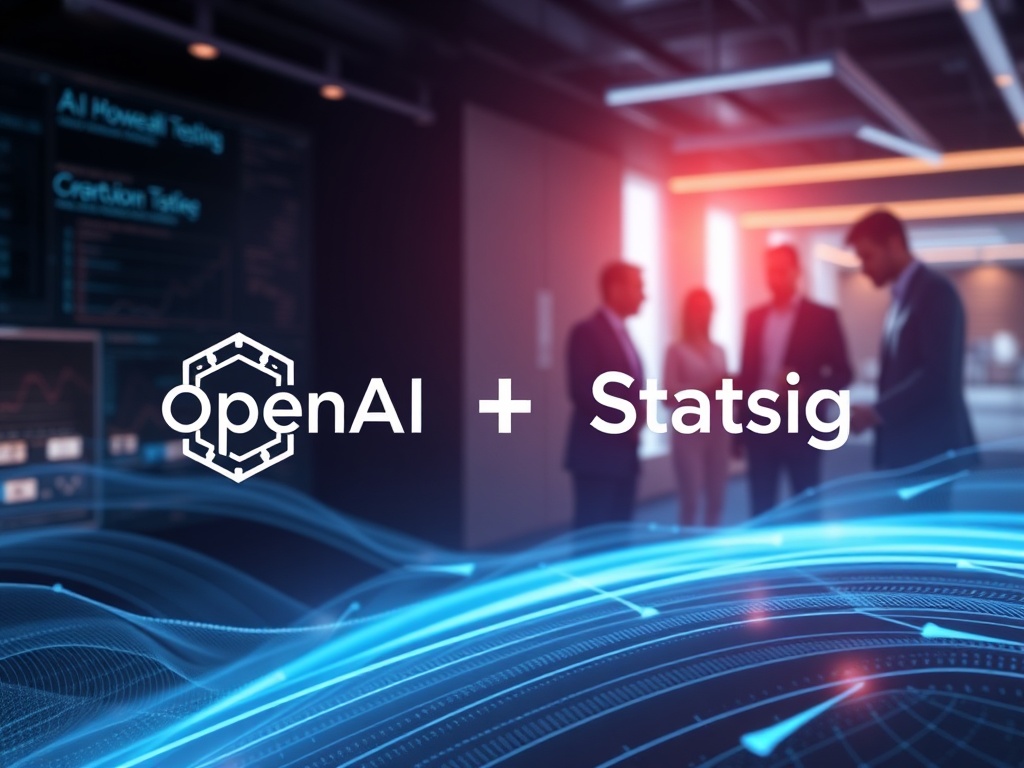OpenAI’s Strategic Leap: $1.1 Billion Statsig Acquisition Fuels AI Applications
0
0

BitcoinWorld

OpenAI’s Strategic Leap: $1.1 Billion Statsig Acquisition Fuels AI Applications
In a world where technological innovation moves at breakneck speed, OpenAI, the creator of ChatGPT, has once again captured headlines with a monumental strategic move. This week, the artificial intelligence powerhouse announced its agreement to acquire Statsig, a prominent product testing startup, for a staggering $1.1 billion in an all-stock deal. This isn’t just a financial transaction; it’s a profound realignment of OpenAI‘s ambitions, poised to dramatically accelerate its AI applications and redefine its leadership team structure.
OpenAI’s Strategic Statsig Acquisition: A Game Changer for AI Applications
The announcement sent ripples across the tech industry, highlighting OpenAI‘s aggressive pursuit of dominance in the rapidly evolving AI landscape. The $1.1 billion Statsig acquisition, one of the largest in OpenAI‘s history, underscores the company’s commitment to enhancing its core offerings and expanding its reach. Valued at an impressive $300 billion, OpenAI‘s move to integrate Statsig’s robust experimentation platform is a clear signal of its intent to streamline and supercharge its product development cycles.
So, why Statsig? Statsig specializes in product experimentation and feature flagging, allowing companies to test new features with specific user segments, analyze their performance, and make data-driven decisions. For a company like OpenAI, which is constantly iterating on complex AI models and user-facing applications, this capability is invaluable. Integrating Statsig means OpenAI can accelerate the testing and deployment of new features for products like ChatGPT and its AI coding tool, Codex, ensuring a more refined and effective user experience.
New Leadership Team Bolsters OpenAI’s Vision: Who’s Leading the Charge?
The Statsig acquisition is not merely about technology; it’s also a strategic talent grab that is reshaping OpenAI‘s organizational chart. Vijaye Raji, Statsig’s founder and CEO, will transition into the pivotal role of CTO of Applications at OpenAI. Raji will report directly to Fidji Simo, the former Instacart CEO who recently joined OpenAI to head its Applications business. This new structure clearly indicates a dedicated focus on building out consumer and enterprise-facing AI applications.
But the changes don’t stop there. OpenAI‘s leadership team is undergoing a broader transformation:
- Vijaye Raji: As the new CTO of Applications, Raji will oversee product engineering for critical products like ChatGPT, Codex, and all future AI applications. His expertise in product experimentation will be crucial for rapid iteration.
- Kevin Weil: The current Chief Product Officer, Kevin Weil, is moving to lead a brand-new initiative called OpenAI for Science. This group aims to build an AI-powered platform to accelerate scientific discovery, working closely with distinguished researcher Sebastien Bubeck. This move highlights OpenAI‘s commitment to pushing the boundaries of AI beyond commercial applications.
- Srinivas Narayanan: The company’s head of engineering, Srinivas Narayanan, will now serve as CTO of B2B Applications. In this role, he will collaborate with COO Brad Lightcap to strengthen OpenAI‘s relationships and offerings for enterprise customers.
These strategic appointments demonstrate OpenAI‘s multifaceted approach to growth, targeting both consumer and enterprise markets while also investing heavily in fundamental scientific advancements.
Accelerating Product Development with Statsig’s Expertise: How Will It Work?
The core benefit of the Statsig acquisition lies in its potential to revolutionize product development within OpenAI. Statsig’s platform allows developers to run A/B tests, manage feature rollouts, and monitor performance metrics in real-time. For OpenAI, this means:
- Faster Iteration: New features for ChatGPT or Codex can be tested with smaller user groups before a full rollout, reducing risk and speeding up development cycles.
- Data-Driven Decisions: Performance data from experiments will directly inform future design and engineering choices, leading to more effective and user-centric AI applications.
- Enhanced User Experience: By quickly identifying and optimizing successful features, OpenAI can deliver a more polished and satisfying experience to its vast user base.
While Statsig will continue to operate independently and serve its existing customer base from its Seattle office, its integration into OpenAI‘s internal processes will be a powerful catalyst for innovation. All Statsig employees will become OpenAI employees, ensuring a seamless transition of talent and expertise.
OpenAI’s Future in AI Applications and Beyond: What’s Next?
This strategic move solidifies OpenAI‘s position not just as a research lab, but as a formidable product company. The emphasis on the Applications business, led by Fidji Simo and now bolstered by Vijaye Raji, signifies a concerted effort to translate groundbreaking AI research into widely adopted products. The expansion into ‘OpenAI for Science’ also hints at a future where AI becomes an indispensable tool for accelerating discovery across various scientific domains, potentially unlocking solutions to some of humanity’s most pressing challenges.
The focus on B2B Applications, guided by Srinivas Narayanan and Brad Lightcap, indicates OpenAI‘s intent to deepen its relationships with enterprise clients, offering tailored AI solutions that drive business value. This comprehensive strategy positions OpenAI to capture significant market share across multiple sectors, leveraging its advanced AI models to create innovative products and services.
Challenges and Opportunities in the Wake of OpenAI’s Expansion
While the Statsig acquisition presents immense opportunities, it also comes with its share of challenges. The deal is currently pending regulatory review, a standard process for large acquisitions that can sometimes introduce delays or require concessions. Furthermore, integrating two distinct company cultures and technological stacks, even with Statsig operating independently, will require careful management to ensure smooth collaboration and continued innovation.
However, the opportunities far outweigh the challenges. This acquisition could cement OpenAI‘s lead in the AI race, enabling it to outpace competitors in product development and feature delivery. By bringing experimentation capabilities in-house, OpenAI gains greater control over its product roadmap and the quality of its AI applications. This strategic consolidation of talent and technology sets the stage for OpenAI to not only maintain its current market position but also to aggressively expand into new frontiers.
In conclusion, OpenAI‘s acquisition of Statsig and the subsequent shake-up of its leadership team mark a pivotal moment for the company. It signifies a decisive pivot towards accelerated product development and a robust expansion of its AI applications across consumer, enterprise, and scientific domains. As OpenAI continues to push the boundaries of artificial intelligence, these strategic moves are likely to have a profound and lasting impact on the entire tech ecosystem, driving innovation and shaping the future of how we interact with AI.
To learn more about the latest AI market trends, explore our article on key developments shaping AI models features.
This post OpenAI’s Strategic Leap: $1.1 Billion Statsig Acquisition Fuels AI Applications first appeared on BitcoinWorld and is written by Editorial Team
0
0
 Manage all your crypto, NFT and DeFi from one place
Manage all your crypto, NFT and DeFi from one placeSecurely connect the portfolio you’re using to start.




